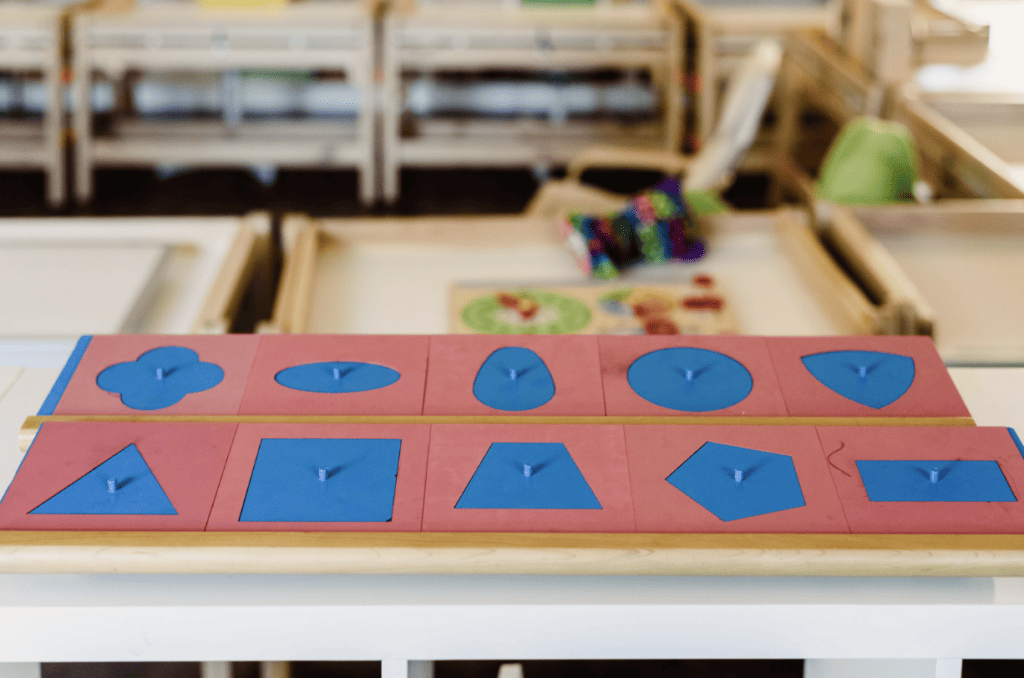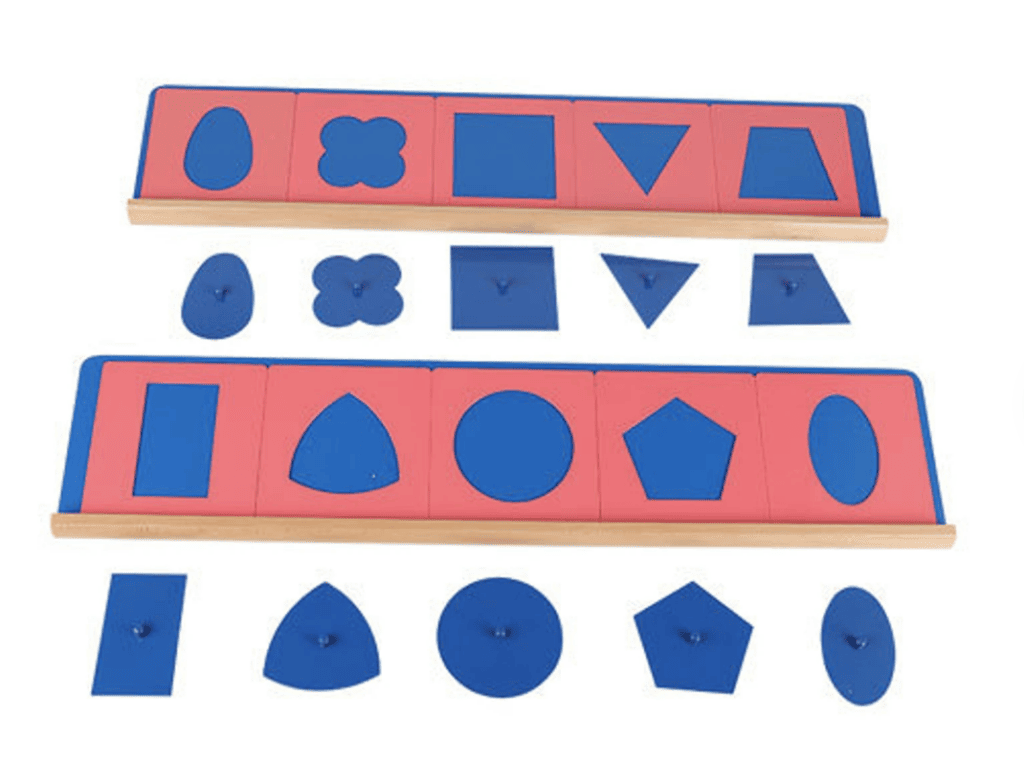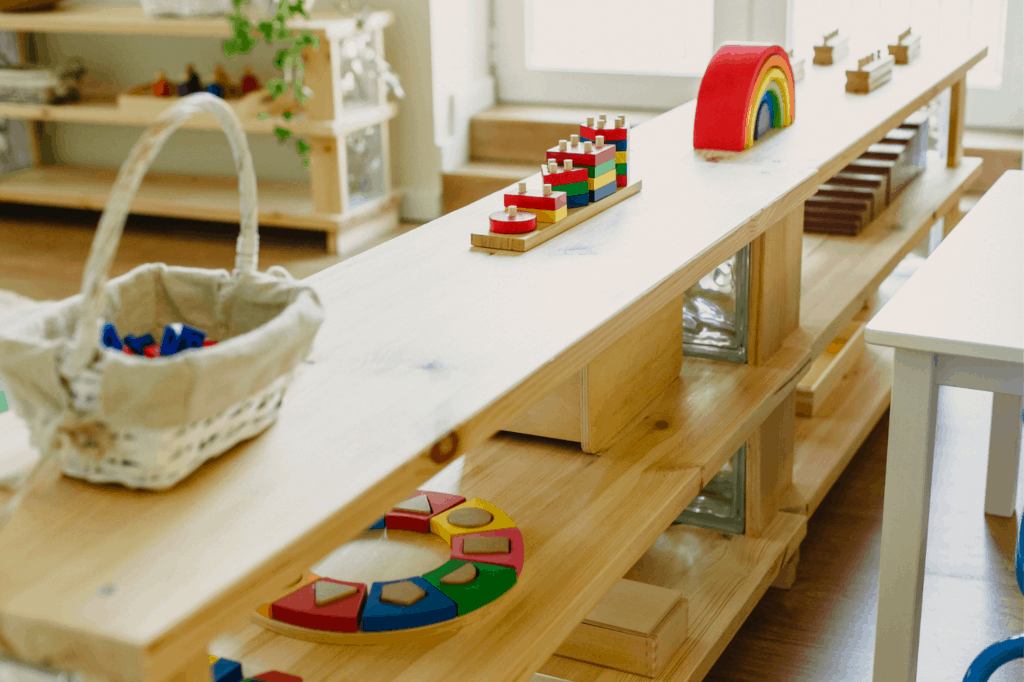One of the most frequent concerns parents have when deciding if
Metal insets are a
Metal insets may seem simple, but they are actually an incredibly complex and intentionally designed tool. Read on to learn more about this tool and how you can use it at home!

Montessori for Today picks out furniture, educational tools, toys and lifestyle items that we think are the best and most exciting, based on independent research and careful consideration. On some occasions we earn revenue (at no additional cost to you) if you click the links and buy the products. But this doesn’t affect what we choose to highlight and we will never let it bias our coverage.
Metal Inset Components and Where to Buy Them
Montessori metal insets are immediately recognizable for their trademark colors and shapes. Most sets of
- Triangle
- Square
- Rectangle
- Pentagon
- Trapezium
The five different curved-line blue shapes in each
- Circle
- Oval
- Ellipse
- Curvilinear Triangle
- Quatrefoil
So, why these shapes in particular? The answer may surprise you: These shapes make up every type of line used in the English alphabet!
Montessori metal insets can be purchased at various

The metal insets themselves are important, but they cannot be used alone. In order for your child to use this tool as Maria
- A tray (the type of tray specifically designed for this activity is preferable, but any tray that your child can carry independently will do in a pinch.)
- Paper
- Writing utensils (most children respond best when given a choice of colored pencils)
How Are Metal Insets Used in Montessori ?
While metal insets might look like some kind of puzzle or geometry game, they are actually a tool used to help younger children (typically ages 3-6) develop the skills they need for writing.
In a non-Montessori school, children are often thrown into writing without any preparation. It’s assumed that, with practice and worksheets, they’ll eventually pick it up. It’s almost as if people believe that children have an instinctual ability to write in the same way that they have an instinctual ability to walk or eat. However, this doesn’t hold true for many children.
While some can certainly pick up writing with ease, many have difficulty with both the physical and intellectual skills necessary to do so. And these difficulties cannot always be overcome through repetition alone, leaving some students frustrated and struggling with letter formation while their peers are dashing off paragraphs and poems.

Due to
Children are given these insets to trace – both the shape itself and the negative space inside the pink inset – which allows them to become acclimated with the fine motor skills needed to form letters. Their muscles adjust to these new movements gradually and appropriately, which gives children both the dexterity and the confidence to clearly and easily form letters when the time comes to do so.
Additionally, as their bodies internalize this work, so do their minds. While their hands and wrists gain strength and dexterity, children’s minds begin creating schemas to understand the two-dimensional shapes and spatial patterns that comprise the symbols we think of as letters. In true
How To Set Up and Introduce Metal Insets
A core tenet of the
The metal insets should have a child-accessible home in whatever room you’ll be keeping them in. Many teachers and parents tend to house them on low shelves or in a special corner of a table. There should be white paper neatly stacked nearby, as well as the writing tray and the colored pencils. A good way to house the colored pencils is to keep them in small cups organized by color.
No matter how these materials are set up they should be within reach of any children that will be using them and it should be clear from how they are arranged that they are all different components of the same activity.
When introducing the metal insets, make sure to keep in mind the driving principle behind both
- First, bring your tray to the metal inset station and place a piece of paper, three colored pencils of your choosing, and one of the metal inset rectangles on your tray. You should choose one of the simpler shapes like the triangle, square, or circle.
- Bring your tray to a table and set up your work space.
- Remove the blue shape from the pink rectangle and set the blue shape aside.
- Place the pink rectangle over your paper.
- Making sure to model holding the pink rectangle firmly in place with your non-dominant hand, use your dominant hand to carefully trace the inside shape, starting at the bottom. Trace around the inner shape several times.
- Carefully remove the pink rectangle to reveal the shape you have traced.
- Select the corresponding blue shape to the one you have traced on your paper. Model placing the shape over your drawing.
- Choose a different colored pencil and trace the outside of the blue shape.
- Remove the blue shape to reveal the new line you have traced. You should emphasize how the two lines match.
After modeling, give your children or students a chance to try. Make sure they follow through with each step of the process – from selecting the inset to tracing their shape. While it’s recommended to allow children to discover variations on this activity independently (e.g. moving the shape around the paper for each new trace to create a pattern or creating a design with different shapes), you can model as needed. As your children or students engage in this activity, make note of their posture, how they hold their pencils, and the pressure with which they press down on the paper and offer guidance if necessary.
Then, sit back and observe as the children become masters of their own learning! Many
How to DIY Metal Insets
The easiest way to acquire a set of Montessor metal insets is to buy the premade versions. However, if money is a barrier, these learning tools can be made at home as well!
Of course, it’s not advisable to make these insets out of metal at home (unless you or someone you know happens to be a metalworker!) That’s okay. While metal is a good material for these tools, given its relative thinness and durability, materials like wood, cardboard, and plastic are workable substitutes. Just remember that these insets will have to stand up to frequent use by young hands!
For those who want to try the DIY route, there are many templates available online. There are also tutorials available, not just for making the insets themselves but for the trays as well.
No matter what route you choose for acquiring
Benefits of Metal Insets
As previously mentioned, the purpose of the
Learning to write is an incredibly complex undertaking. Many people mistakenly believe that it’s a purely intellectual process. Once a child understands the alphabet and memorizes the way each letter looks, they should be able to write with ease after a little practice. However, anyone who has been around young children knows that this is not the case. Consider everything that goes into writing a lowercase “e”:
- You have to be able to draw a straight line.
- You have to be able to draw a curved line.
- You have to be able to draw a part of a circle, while still keeping the circle open.
- You have to be able to draw lines of a specific length.
- You have to be able to place your lines close enough together that they can connect.
- You have to be able to connect different kinds of lines without overlapping or scribbling.
- You have to continue holding your pencil upright and at the same angle so that your lines go where you want them to on the page.
Now, think of what most kindergarten drawings look like. These are not skills that come naturally to children!
Unfortunately, the mainstream approach that writing is a discrete skill easily picked up by any kindergartner who knows their letters can mean that children end up struggling with fine motor skills and letter formation for many of their earlier school years. Young students complain of cramped fingers and sore hands. Many avoid writing altogether and are pushed into remedial classes that they don’t actually need, spending their time tracing letters instead of learning new vocabulary, syntax, and writing craft.
These children may eventually learn how to write, but it will be much harder for them to learn to love writing. Some adopt writing styles that damage the delicate muscles and tendons in their developing hands, which will require occupational therapy interventions later on.

By using these metal insets, the
Montessori metal insets also have some “bonus” benefits as well! In addition to the obvious fine-motor benefits, these insets can help children learn about geometry, grow their spatial awareness, and help them develop a baseline understanding of patterns and design concepts.
More than anything,
Children clamor for a chance to trace these interesting shapes using their favorite colored pencils. And, because this activity is not framed as a simple means to an end but as a new way to explore their world, students are able to engage their creative side with this activity as they use the insets to create beautiful designs and patterns. This may be the most important aspect of







